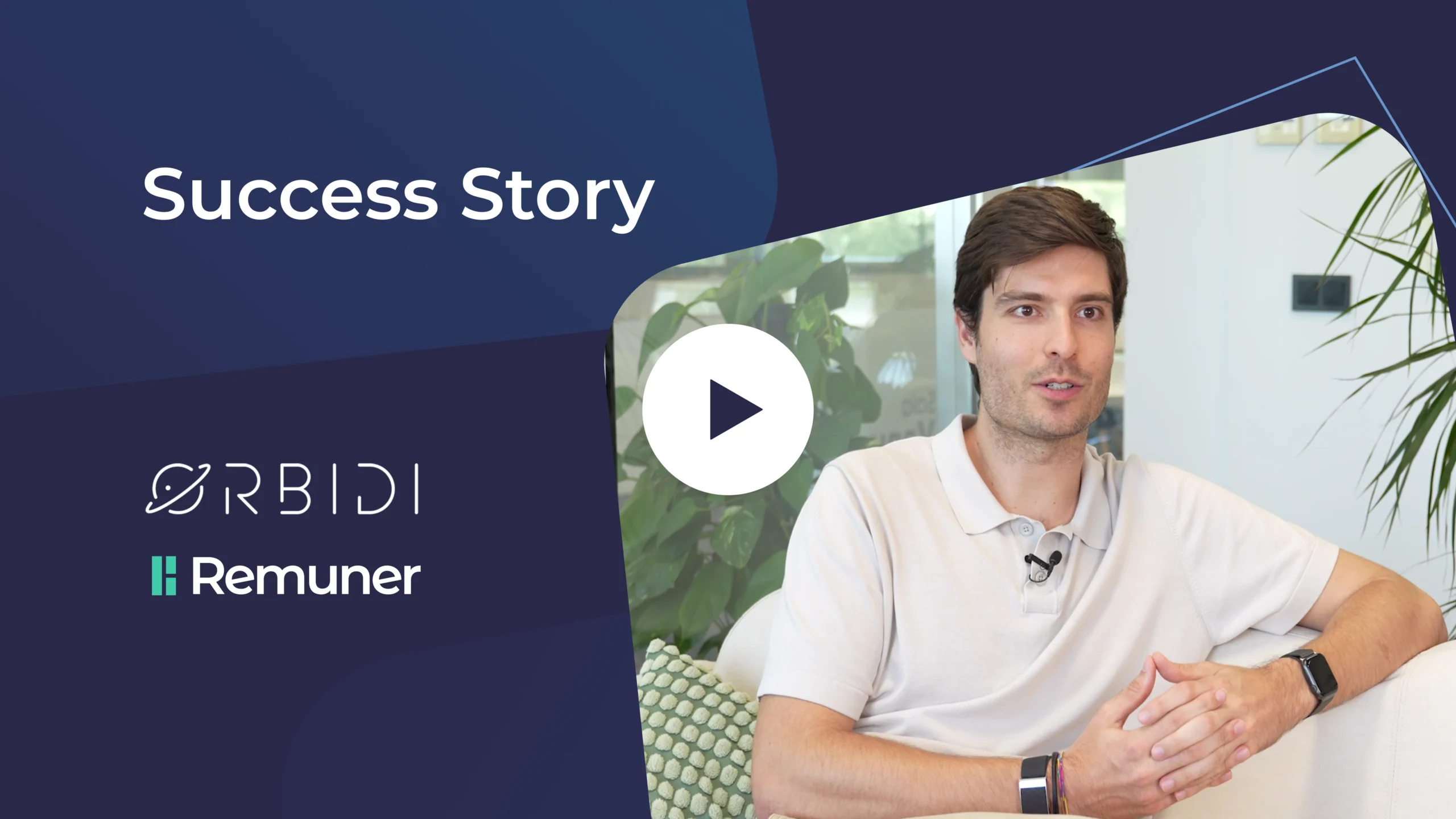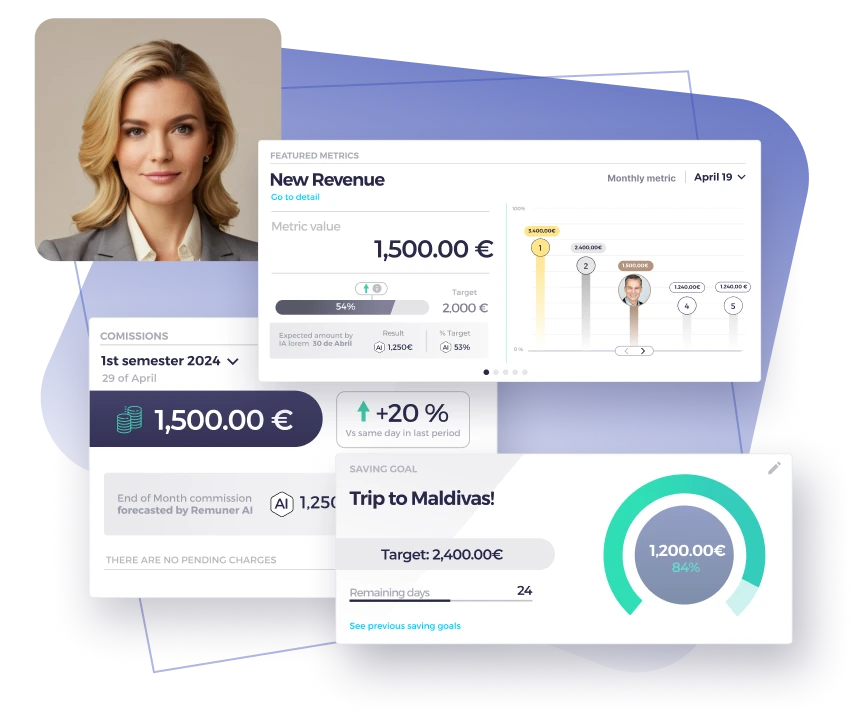Table of contents
Building an effective bonus structure is key to improving motivation, accountability, and overall sales performance. The right bonus system not only helps reward employees for meeting specific goals—it also aligns individual actions with company growth.
In this post, we’ll explore the most effective types of bonus structures, when to use them, and real-world bonus structure examples. Whether you’re designing a plan for your sales team, direct sellers, or cross-functional departments, this guide will help you structure a plan that works.
We’ll also show how tools like Remuner can simplify bonus programs, help track OTE and quotas, and ensure compensation plans are aligned with company goals.
What is a Bonus Structure?
A bonus structure defines how team members can be financially rewarded beyond their base salary. These bonus payouts are typically tied to performance metrics, specific goals, or broader company achievements.
Bonus systems can apply to:
- Individual sales reps
- Teams or departments
- Entire organizations
They are commonly used to motivate employees, retain talent, and encourage long-term success.
Why do companies use bonus structures?
Companies use bonus structures to:
- Incentivize productivity through clearly defined performance goals
- Attract and retain talent with competitive employee bonus plans
- Drive specific behaviors that align with business objectives
- Improve visibility into sales compensation plans and OTE
- Boost morale by showing appreciation through performance bonuses
But to work effectively, these programs need to be clear, trackable, and achievable.
10 Bonus Structure Example + Tips
1. Revenue-based bonus
This structure offers a bonus amount based on the revenue an individual or team generates. It’s one of the simplest and most popular bonus programs for sales teams.
Example:
- A sales rep earns a 5% bonus on all closed deals in Q1.
- If they close $200,000, they receive a $10,000 bonus payout.
Best for:
- Sales reps and account executives (AEs)
- Simple sales compensation plans
Common challenge:
Tracking revenue accurately across platforms. Tools like Remuner’s commission tracking software automatically sync deals, quotas, and payouts to ensure transparency.
2. Milestone bonus
Milestone bonuses are tied to achieving specific goals like launching a product, opening a new market, or completing a complex project.
Example:
- A team receives a $3,000 spot bonus for launching a new feature within deadline and budget.
Best for:
- Product, marketing, or operations teams
- Short-term motivation and one-time initiatives
Common challenge:
These bonuses often go untracked or become subjective. Remuner helps standardize milestone payouts, so you can reward employees fairly and consistently.
3. Quota-attainment bonus
This is a classic bonus structure example in direct selling and B2B sales. Bonuses are awarded when reps hit or exceed their sales quotas.
Example:
- Quota: $100,000/month
- Bonus tiers:
- 100% of quota = $1,000 bonus
- 110% = $2,000
- 120% = $3,500
Best for:
- Sales teams with aggressive growth targets
- Environments with measurable KPIs
Pro tip:
Tie quotas to realistic OTE (on-target earnings) to avoid demotivation.
4. Tiered commission bonus
In this structure, commission rates increase as reps cross higher revenue thresholds. It rewards high performers while still giving lower performers something to aim for.
Example:
- 5% commission on the first $50K in sales
- 7% from $50K–$100K
- 10% on anything above $100K
Best for:
- Experienced sales reps
- High-ticket B2B sales
Why it works:
This approach motivates employees to push beyond their targets. It also aligns well with a long term strategy for rewarding growth.
5. Profit-sharing bonus
Employees receive a percentage of company profits, either quarterly or annually. It promotes ownership and long-term thinking.
Example:
- Company allocates 5% of annual profits to be shared equally across eligible team members.
Best for:
- Startups or lean companies
- Teams that contribute collectively to outcomes
Limitations:
Hard to track unless your financial systems are integrated. Remuner helps ensure financial performance connects to bonus payouts transparently.
Take a look at Investopedia’s article about profit sharing plans to understand what it is and how it works.
6. Spot bonus
A spot bonus is a one-time reward for outstanding performance, given without prior notice.
Example:
- A customer success rep receives a $500 spot bonus for retaining a major client who was at risk of churn.
Best for:
- Encouraging initiative and ownership
- Creating moments of recognition
Caution:
Too many unstructured bonuses can create confusion. Use Remuner to document and analyze all bonus payouts consistently.
7. Referral bonus
Companies pay employees for referring qualified candidates who get hired.
Example:
- $500 after the referred candidate is hired
- Additional $500 after 6 months of employment
Best for:
- Fast-growing teams
- Reducing recruiting costs
Bonus tip:
You can gamify referral bonuses and add them to a wider compensation plan using software like Remuner.
8. Team-based bonus
Instead of rewarding individuals, team bonuses align departments to shared performance metrics.
Example:
- Marketing and sales hit a joint MQL-to-opportunity conversion rate.
- Each team member receives a $1,000 bonus payout.
Best for:
- Cross-functional collaboration
- Aligning departments to common KPIs
Downside:
Overperformance by one member may not get fully recognized. Combine team bonuses with individual rewards through Remuner’s hybrid bonus systems.
9. Goal-based bonus
This plan ties bonuses to the completion of personalized performance goals, which may not always be directly revenue-generating.
Example:
- A sales enablement manager is rewarded for training 100% of new SDRs within 30 days.
Best for:
- Mid-level managers and support teams
- Organizations with varied roles
Best practice:
Link goal completion to clear performance metrics. Remuner lets you define, track, and adjust these objectives with transparency.
10. Retention bonus
Used to retain key talent during critical periods—such as a company sale or leadership transition.
Example:
- A senior sales director receives a $20,000 retention bonus for staying through a 12-month restructuring.
Best for:
- Strategic talent planning
- Long-term project continuity
Caution:
Retention bonuses work best with ongoing engagement, not just money. Track long-term incentive effectiveness through Remuner.
Best practices for implementing a bonus structure
1. Start with your compensation philosophy
Define whether you value performance, tenure, collaboration, or innovation most. Your bonus programs should reflect these values.
2. Keep your bonus structure transparent
Ambiguity creates distrust. Every employee should understand how their bonus amount is calculated and when they will receive it.
3. Align bonuses with your sales compensation plan
Your bonus systems should reinforce—not conflict with—your broader compensation and OTE structures.
4. Track performance metrics accurately
Whether it’s quota attainment, direct selling KPIs, or support goals, clarity on what you’re measuring is essential.
Tools like Remuner centralize these components: quota setting, OTE modeling, commission tracking software, and bonus visibility.
If you’re designing a long-term program tied to annual performance goals, it’s worth understanding how annual incentive plans work. These are structured bonus programs designed to align year-end payouts with business outcomes. Check out our full guide to creating an annual incentive plan to learn how to build a sustainable bonus strategy.
How Remuner helps with bonus structure management
Designing bonus structures is one thing. Managing them is another. Here’s how Remuner solves the biggest challenges in bonus compensation:
1. Track bonuses in real time
Say goodbye to spreadsheets and miscommunication. Remuner integrates with your CRM and finance tools to track sales incentives and bonus payouts automatically.
2. Align incentives with OTE and quota
Build smarter sales compensation plans by modeling realistic earnings expectations for each role.
3. Reward employees across all departments
Create tailored employee bonus plans that go beyond sales—from marketing milestones to support excellence and referral bonuses.
4. Improve team-wide visibility
Let team members see their bonus performance, track progress toward specific goals, and understand the bonus systems that apply to them.
FAQ: Bonus structure example and related questions
What is a bonus structure example?
A bonus structure example shows how a company rewards performance through additional compensation. It can be based on revenue, quotas, milestones, referrals, or profit-sharing.
What is direct selling?
Direct selling is a sales method where products or services are sold directly to consumers, often outside of a retail environment. Sales reps in direct selling often use bonus programs to increase motivation.
What are sales incentives?
Sales incentives are financial or non-financial rewards given to salespeople for achieving certain performance metrics. These are key elements in a sales compensation plan.
How do you calculate OTE?
OTE (on-target earnings) combines base salary with expected bonus or commission if the rep hits 100% of quota. Use tools like Remuner to model and forecast realistic OTE based on past performance.
What’s the best commission tracking software?
The best commission tracking software automates payouts, integrates with CRMs, and helps forecast compensation costs. Remuner is built specifically to handle these needs for growing revenue teams.
What makes a good sales compensation plan?
A good sales compensation plan aligns business goals with employee motivations, offers clear targets (like quota), and provides fair and timely rewards—often structured with bonuses and performance-based incentives.





